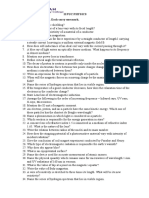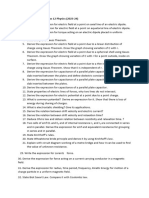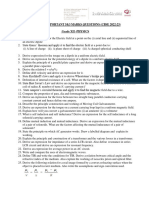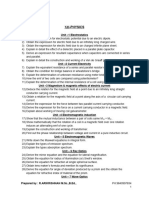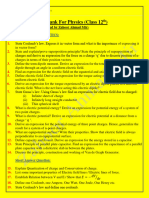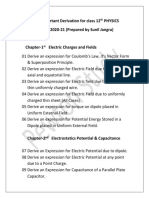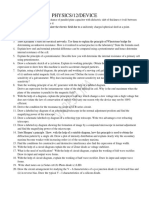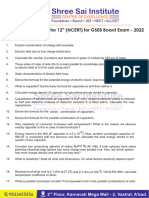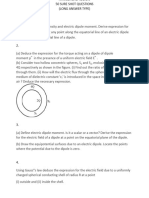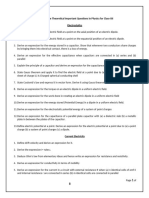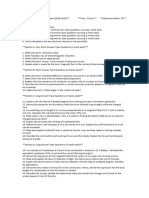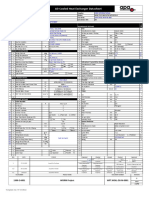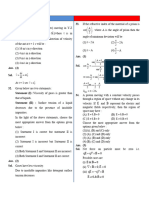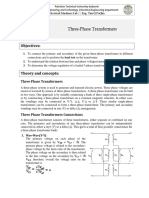Physics Questions CBSE
Physics Questions CBSE
Uploaded by
mohithraganesan07Copyright:
Available Formats
Physics Questions CBSE
Physics Questions CBSE
Uploaded by
mohithraganesan07Copyright
Available Formats
Share this document
Did you find this document useful?
Is this content inappropriate?
Copyright:
Available Formats
Physics Questions CBSE
Physics Questions CBSE
Uploaded by
mohithraganesan07Copyright:
Available Formats
Physics questions
1. Calculate the electric field due to a dipole on its axial line and equatorial plane.
2. Derive an expression for the torque experienced by a dipole due to a uniform electric field.
3. Obtain the expression for electric field due to an infinitely long charged wire.
4. Obtain the expression for electric field due to an uniformly charged spherical shell.
5. Obtain the expression for electric field due to a charged infinite plane sheet.
6. Obtain the expression for capacitance for a parallel plate capacitor.
7. Obtain the expression for energy stored in the parallel plate capacitor.
8. Obtain the expression electrostatic potential at a point due to an electric dipole.
9. Explain the determination of the internal resistance of a cell using voltmeter.
10. Obtain the condition for bridge balance in Wheatstone’s bridge.
11. State Joule’s law of heating. Derive the expression for power P=VI in electrical circuit.
12. Obtain a relation for the magnetic field at a point along the axis of a circular coil carrying
current using Biot-Savart law.
13. Find the magnetic field due to a long straight conductor using Ampere’s circuital law.
14. Derive the expression for the torque on a current-carrying coil in a magnetic field.
15. Calculate the magnetic field inside and outside of the long solenoid using Ampere’s circuital
law.
16. Explain the principle and working of a moving coil galvanometer. Find how the voltage
sensitivity differs due to Resistance.
17. Give an illustration of determining direction of induced current by using Lenz’s law.
18. Show that the mutual inductance between a pair of coils is same (M12 = M21).
19. Elaborate the standard construction details of AC generator.
20. Explain the construction and working of transformer. Efficiency of the transformer with
energy loses.
21. Obtain an expression for average power of AC over a cycle. Discuss its special cases.
22. Obtain lens maker’s formula and mention its significance.
23. Derive the equation for angle of deviation produced by a prism and thus obtain the equation
for refractive index of material of the prism.
24. A beam of light consisting of red, green and blue is incident on a right-angled prism as shown
in figure. The refractive index of the material of the prism for the above red, green and blue
colours is 1.39, 1.44 and 1.47 respectively. What are the colours suffer total internal
reflection?
25. Explain the Young’s double slit experimental setup and obtain the equation for path
difference.
26. Obtain the equation for resultant intensity due to interference of light. Light of
wavelength 600 nm that falls on a pair of slits producing interference pattern on a screen
in which the bright fringes are separated by 7.2 mm. What must be the wavelength of
another light which produces bright fringes separated by 8.1 mm with the same
apparatus?
27. Explain how frequency of incident light varies with stopping potential. (2)
28. Explain experimentally observed facts of photoelectric effect with the help of Einstein’s
explanation.
29. Derive an expression for de Broglie wavelength of electrons.
30. State de Broglie hypothesis. (2)
31. Derive the energy expression for an electron is the hydrogen atom using Bohr atom
model.
32. Describe the working of nuclear reactor with a block diagram.
33. What is mean life of a radioactive nucleus? Give the expression.
34. What is half-life of a radioactive nucleus? Give the expression.
35. Draw the circuit diagram of a half wave rectifier and explain its working.
36. Explain the construction and working of a full wave rectifier.
37. What is meant by Depletion region? (2)
38. Define barrier potential. (2)
39. What is rectification? (2)
40. Distinguish between intrinsic and extrinsic semiconductors.
You might also like
- II PUC PHYSICS Enrichment PackageDocument4 pagesII PUC PHYSICS Enrichment PackageSohum VenkatadriNo ratings yet
- 12 - TH 3-Mark QuestionsDocument6 pages12 - TH 3-Mark Questionssameernazeer19751975No ratings yet
- Important Derivations Class 12 Physics (Term 1)Document3 pagesImportant Derivations Class 12 Physics (Term 1)hsofficial910No ratings yet
- Physics Class 12th Important 5 Mark QuestionDocument4 pagesPhysics Class 12th Important 5 Mark Questionnothingto1000No ratings yet
- Physics Important Derivations QuestionDocument3 pagesPhysics Important Derivations QuestionsumitNo ratings yet
- REVISION Important 5&3 Marks Xii PhysicsDocument2 pagesREVISION Important 5&3 Marks Xii PhysicsGeethika gorakala100% (1)
- Imp. Derivations For XII PhysicsDocument3 pagesImp. Derivations For XII PhysicsJethiya SyckoNo ratings yet
- Frequently Asked Questions 2023 XiiDocument4 pagesFrequently Asked Questions 2023 XiiBala MugeshNo ratings yet
- New Microsoft Word DocumentDocument3 pagesNew Microsoft Word DocumentRuprabh KumarNo ratings yet
- LIST OF IMPORTANT DERIVATIONS - CLASS XII (PHYSICS) Term 1Document3 pagesLIST OF IMPORTANT DERIVATIONS - CLASS XII (PHYSICS) Term 1satyamroy0010No ratings yet
- MLL Autumn BreakDocument1 pageMLL Autumn Breakmahadevipatil.patil04No ratings yet
- 12thgolden5mark24 25pyemDocument1 page12thgolden5mark24 25pyemnirmal0708nkNo ratings yet
- 12th Physics Unit 1 To 10 Important Details English Medium PDF DownloadDocument3 pages12th Physics Unit 1 To 10 Important Details English Medium PDF Downloadprasathonline95No ratings yet
- 12 Physics Chapter Wise Important QuestionsDocument5 pages12 Physics Chapter Wise Important QuestionsRuhul Alam ChoudhuryNo ratings yet
- Classxiiassignment201920Document84 pagesClassxiiassignment201920Dhaval KumarNo ratings yet
- Re Exam QuestionsDocument2 pagesRe Exam Questionsabuthahir1.mcaNo ratings yet
- 12thQuestionBank (KSU)Document9 pages12thQuestionBank (KSU)sohailmushtaq1001No ratings yet
- Important QuestionsDocument26 pagesImportant QuestionsAyush TomarNo ratings yet
- Physics Question BankDocument15 pagesPhysics Question Bankepicgaming0455No ratings yet
- Phy SeniorsDocument6 pagesPhy SeniorsRaj KumarNo ratings yet
- 1 Hand Written Imp 2025 F5 BestDocument18 pages1 Hand Written Imp 2025 F5 Bestletsrockitbby69No ratings yet
- Xii Pb2 AssignmentDocument2 pagesXii Pb2 Assignmentmehaktyagi422No ratings yet
- Passing and Scoring Package For II Pu PhysicsDocument6 pagesPassing and Scoring Package For II Pu Physicsitxkevin28No ratings yet
- Electricity - Revision WorksheetDocument7 pagesElectricity - Revision Worksheetmk.afeefuddinNo ratings yet
- PhysicsDocument13 pagesPhysicsSubhanshu BabbarNo ratings yet
- Theory Question BankDocument3 pagesTheory Question BankSiddhartha DasNo ratings yet
- SR Physics Fast LearnerDocument7 pagesSR Physics Fast LearnerShahrukh KhanNo ratings yet
- Chapterwise Questions - 12 PhyDocument9 pagesChapterwise Questions - 12 Phymukeshprajonkajol977No ratings yet
- Cbse Paper Leak PDFDocument7 pagesCbse Paper Leak PDFRohan AroraNo ratings yet
- 2209 ENTHUS PHASE ALL 1901CJA101021240067 StudentDocument3 pages2209 ENTHUS PHASE ALL 1901CJA101021240067 Studentjaykelani2006No ratings yet
- Chapter Wise Important QuestionsDocument4 pagesChapter Wise Important QuestionsTechnical Hacks100% (1)
- Chapter Wise Important Question Xiith PhysicsDocument5 pagesChapter Wise Important Question Xiith PhysicsTamanna SahuNo ratings yet
- XII Theory AssignmentDocument2 pagesXII Theory AssignmentsamarthNo ratings yet
- Important Questions PhysicsDocument12 pagesImportant Questions PhysicsNaziaParveenNo ratings yet
- Xii 5m Yearwise QuestionsDocument3 pagesXii 5m Yearwise Questionssyedrayan121313No ratings yet
- Physics 2nd Yr BDocument3 pagesPhysics 2nd Yr BShahrukh KhanNo ratings yet
- Compiled Physics Question Bank For Class 12Document10 pagesCompiled Physics Question Bank For Class 12yashikaagarwal180107No ratings yet
- Most Important Derivation For Class 12th PHYSICSDocument6 pagesMost Important Derivation For Class 12th PHYSICSYash Morjhawal88% (8)
- Chapter Wise Important Questions XII PHYSICSDocument8 pagesChapter Wise Important Questions XII PHYSICSsavitridevi9668100% (1)
- DEVICEDocument1 pageDEVICEweeb.with.internet.accessNo ratings yet
- CH 13 Magnetic Fields of Electric Current DPP - 01Document1 pageCH 13 Magnetic Fields of Electric Current DPP - 01HemantBhardwajNo ratings yet
- Sri Sai Institute TestDocument20 pagesSri Sai Institute Testpurchase sigmaairsourceNo ratings yet
- Planner For Preparatory Exam.Document3 pagesPlanner For Preparatory Exam.RaonarNo ratings yet
- DERIVATIONS AND CONCEPTS - BOOK-1pDocument3 pagesDERIVATIONS AND CONCEPTS - BOOK-1ptessaNo ratings yet
- Top 70 Question Physics.Document13 pagesTop 70 Question Physics.Shan DubeyNo ratings yet
- Important Board Questions 3Document12 pagesImportant Board Questions 3sjrNo ratings yet
- QB EmtDocument5 pagesQB EmtSankar KaruppaiahNo ratings yet
- Bio BotanyDocument3 pagesBio BotanyfjustinwilfredNo ratings yet
- Navaneeth 5marks PDFDocument3 pagesNavaneeth 5marks PDFPranav AdithNo ratings yet
- 12th Physics Important Derivation Harshit SirDocument4 pages12th Physics Important Derivation Harshit Siradarshtiw787No ratings yet
- EC2253 Question BankDocument7 pagesEC2253 Question BankshubhamsouravNo ratings yet
- +2 Physics Very Important QuestionsDocument2 pages+2 Physics Very Important Questionsaksa.bonvoyageNo ratings yet
- Xii Derivation List-2023-24 2Document3 pagesXii Derivation List-2023-24 2prachurjyapadhiNo ratings yet
- Physics Important Questions For 2PUDocument40 pagesPhysics Important Questions For 2PUsandhya572210No ratings yet
- 12 2005 Physics 2Document5 pages12 2005 Physics 2Dr. Pradeep Kumar SharmaNo ratings yet
- Theoretical Important Questions External ResourceDocument8 pagesTheoretical Important Questions External Resourcebishnoieklavya7No ratings yet
- Sample Paper - 2009 Class - XII Subject - : PhysicsDocument4 pagesSample Paper - 2009 Class - XII Subject - : PhysicsPiyush SinghNo ratings yet
- Physics Paper 1Document2 pagesPhysics Paper 1vipinshrivastav2610No ratings yet
- XII 3m YEARWISE QUESTIONSDocument3 pagesXII 3m YEARWISE QUESTIONSsyedrayan121313No ratings yet
- Principles of Solar Cells, LEDs and Related Devices: The Role of the PN JunctionFrom EverandPrinciples of Solar Cells, LEDs and Related Devices: The Role of the PN JunctionNo ratings yet
- Fundamentals of Liquid Measurement IDocument6 pagesFundamentals of Liquid Measurement Imanuel_medcoNo ratings yet
- Oversizing of Solaredge Inverters, Technical NoteDocument1 pageOversizing of Solaredge Inverters, Technical NoteMohammad HamamdNo ratings yet
- Questions of Chapter OneDocument2 pagesQuestions of Chapter OneNasser Shelil100% (2)
- Motor Compressor Coupling FailureDocument18 pagesMotor Compressor Coupling Failuresatya krishna chagantiNo ratings yet
- WPT - Woll Ds M 0001 1 IpDocument4 pagesWPT - Woll Ds M 0001 1 IpParag ThakkarNo ratings yet
- Thermal - Expansion and ConductivityDocument7 pagesThermal - Expansion and ConductivityrasprasadNo ratings yet
- Vectors WS 2 1Document31 pagesVectors WS 2 1Nisali MendisNo ratings yet
- Water HammerDocument89 pagesWater HammerSajid NazirNo ratings yet
- Nexus 1500 Transient Recording Power Quality Revenue Meter User Manual v.1.12 - E154701Document258 pagesNexus 1500 Transient Recording Power Quality Revenue Meter User Manual v.1.12 - E154701killer klausNo ratings yet
- Grade 5 Module Week 4Document15 pagesGrade 5 Module Week 4KENEDY FLORESNo ratings yet
- 2024 Physics Board Paper Set 3Document13 pages2024 Physics Board Paper Set 3shivkarnwal2No ratings yet
- ACFrOgBovNzM3z4ctdBtdvvWOoeLBR9Z5H-YsbOcq8lD FzxmZYMmE f-9NKT-O7MRFo70yvw1ou2aWjDhXAUPRSmIzluVaVFq0sIwHC6 9WuxlXNfyFV4SIH0dZUUkDocument4 pagesACFrOgBovNzM3z4ctdBtdvvWOoeLBR9Z5H-YsbOcq8lD FzxmZYMmE f-9NKT-O7MRFo70yvw1ou2aWjDhXAUPRSmIzluVaVFq0sIwHC6 9WuxlXNfyFV4SIH0dZUUkmaghraouiNo ratings yet
- JEE Mains 2024 Jan 27 Shift 1Document6 pagesJEE Mains 2024 Jan 27 Shift 1kapilrajak.nitwNo ratings yet
- National Institute of Technology Rourkela End - Semester ExaminationDocument2 pagesNational Institute of Technology Rourkela End - Semester Examinationsunny kumarNo ratings yet
- Eao 10-2J13.1065 - Single-LEDDocument2 pagesEao 10-2J13.1065 - Single-LEDLeandro GomesNo ratings yet
- HW Section2 PhysicsDocument4 pagesHW Section2 PhysicsNeverthelessNo ratings yet
- Thermal Conductivity of MetalDocument71 pagesThermal Conductivity of MetalDina TarekNo ratings yet
- PascoDocument75 pagesPascoJorge Zanoni Ruiz FraustoNo ratings yet
- Ktunotes - In: 1. Self Control Mode Using A Rotor Position Sensor or Stator Voltage SensorDocument6 pagesKtunotes - In: 1. Self Control Mode Using A Rotor Position Sensor or Stator Voltage SensorSuganthiVasanNo ratings yet
- Quantum Mechanics:Wave Packet, Phase Velocity and GroupDocument54 pagesQuantum Mechanics:Wave Packet, Phase Velocity and Groupvivek patelNo ratings yet
- DG Allocation ResearchgateDocument20 pagesDG Allocation ResearchgategeetikaNo ratings yet
- Commercial and Public BuildingsDocument14 pagesCommercial and Public BuildingsTsz Ho LAINo ratings yet
- Guide To Choosing Generator To Motor SizeDocument2 pagesGuide To Choosing Generator To Motor SizeMarlone RodriguezNo ratings yet
- Derivatives Sample Word Problems With SolutionsDocument6 pagesDerivatives Sample Word Problems With SolutionsMhyl HitsuyagamikaelsonNo ratings yet
- Daikin Eco King Wall Mounted BrochureDocument6 pagesDaikin Eco King Wall Mounted Brochuregene josueNo ratings yet
- Mole and Molar Mass of Elements and Compounds - ReportDocument12 pagesMole and Molar Mass of Elements and Compounds - ReportIngrid Kim100% (2)
- Investigation of Diffusivity and Viscosity in Solar PlasmaDocument6 pagesInvestigation of Diffusivity and Viscosity in Solar PlasmaPradeep ChauhanNo ratings yet
- Homework2 SolutionsDocument12 pagesHomework2 SolutionsAdnan AnwerNo ratings yet
- Modul 11 - Response Spectrum AnalysisDocument66 pagesModul 11 - Response Spectrum AnalysisDYNNo ratings yet
- Three-Phase Transformers: ExperimentDocument8 pagesThree-Phase Transformers: ExperimentKoti ReddyNo ratings yet
